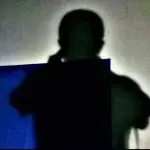If there's one element that defines "Ripley," it might just be shadows. Projections, silhouettes, reflections, shading, darkness, and outlines - the use of shadows transforms this story from decades ago into something completely different. Who would have thought that in 2024, we'd still see a black-and-white drama series? In terms of form, "Ripley" took a big step back in a very adventurous and exciting leap. It became a pioneer with a conservative appearance and created complexity with minimalist tones, trying to hide its true nature.

At the beginning, when a man drags a body down a staircase of marble, and their massive shadows are cast on the wall, you know that a classic crime story is unfolding. It has that Hitchcock vibe, that rejection of the present, and that fascination with old-fashioned details. In other words, it's timeless, eternal.
The phrase "Light is the soul of painting" appears more than once throughout the series. When Ripley stands in churches and museums, gazing at works by Caravaggio, and the silent men behind her suddenly speak these words, they feel like prophecies and allegories. As the story unfolds amidst countless overlapping shadows, the meaning of "Light is the soul of painting" reveals itself in a unique way. It refers not only to the techniques used in paintings but also to the show's technique and, more subtly, to the brightness and grayscale of human nature within the story.

What masterpieces does this TV series remind fans of? Perhaps it should be "The White Lotus", as well as "The New Pope" and "The Young Pope". Not only because the stories are set in Italy, but also because of a common concern for authorship and strong control over the narrative - they care not only about "story" and "plot", but also about "form" and "structure", and more explicitly, about composition and color. How the story is told is much more important than the story itself. It's the "tone" of the telling and the perspective that make these extremely unique and individualistic TV series stand out. If "The White Lotus" "The New Pope" and "The Young Pope" use endless dazzling colors to create a desolate reflection of the inner world, then "Ripley" is just the opposite, using only black and white and light and dark contrasts to shape a flower of evil that is actually colorful and brilliant.
Those who haven't seen it may not understand why a black-and-white TV series like "Ripley" is related to color. That's because the director cleverly uses a reverse extraction method. Italy's rich color palette is well known. Under the premise of public knowledge, director Steven Zaillian - who has participated in "The Irishman" and "The Night Of" - completely obscures it with black and white. This not only does not hide the richness and brilliance of the original colors, but also stimulates the audience's reconstruction and imagination of those colors. Turning passive viewing into active participation, you face a black-and-white screen and fill the screen with bright colors in your own mind. The process is far more thrilling and impressive than directly seeing the colors. This is a strange feeling, as strange as the story itself.

"Ripley" is based on the famous novel "The Talented Mr. Ripley" and has been adapted into movies several times, with the most famous version starring Matt Damon. For readers who enjoy this genre, it's not an unfamiliar story; in fact, it's like a classic in this circle. However, under such a premise of being too familiar, "Ripley" relies on its emphasis on form to turn a typical story into a director's film.
It's the story of Ripley, a con artist living on the edge of poverty, who forges fake documents to deceive strangers. His fate takes a turn when a wealthy businessman hires him to persuade his son, Dickie, living a life of luxury in Italy, to return home. In Italy, Ripley transforms from an uncertain foreigner to a resourceful scammer, motivated by Dickie's wealth. He gradually replaces Dickie as his confidant, showcasing a slow, insidious evil. While the murders in the story are sudden and bloody, the focus is on the slow buildup to these events, highlighting the quiet capture of the victim until the moment of killing arrives unexpectedly.

The outer shell of the story "Ripley" is social and legal, related to deception and concealment. However, as the story unfolds, its core becomes spiritual, exploring identity construction, recognition, alteration, and the dislocation, reset, and possibilities of self-awareness. It is these subtle, ambiguous, and hard-to-express elements that elevate the story.
Throughout the show, there are many scenes where Ripley is alone in a room, imagining a conversation with someone. Sometimes, it's a rehearsal for usurping someone else's identity, and other times it's a rehearsal for dealing with the upcoming police. These imaginary performances become some of the most surreal moments in the story, with actor Andrew Scott portraying an elegant collector at a party one moment and a savage butcher in a meat shop the next.
Ripley is a man who's out of touch with society, anti-social even. Yet he effortlessly and easily blends in, making a living by manipulating and playing people. It's almost all subconscious for him; morality doesn't exist in his world. In that sense, is he even human? He's a rational madman, a wise lunatic.

Italy is unique. It's both a place and a time, preserving ancient history through countless sculptures, paintings, and public buildings. Humans come and go, but the backdrop remains unchanged. This eerie story unfolds within this setting, creating a different kind of meaning. The camera glides over tranquil seas, massive domes, and endless colonnades, deliberately slowing down each frame and shot. Despite the deliberate pacing, the scenes flow seamlessly together. The frowning faces of grandiose gods resemble eternal surprise and weariness as they gaze upon the absurdity, suffering, joys, and sorrows of humanity. They witness the endless repetition of sin and foolishness without any restraint. For a TV series, these extravagant shots are truly luxurious.
Classical crime stories hold a certain allure compared to modern ones, as they existed in a world where secrets thrived before technology transformed society into a panoramic prison, eliminating grayscale and secrecy. "Ripley" unfolds in a world devoid of cameras, DNA, or facial recognition, requiring detectives to physically explore and investigate, imbuing the suspense with a unique sense of motion. Staircases and elevators become powerful metaphors, symbolizing ascent into someone else's life and the descent of dragging a body, or the unpredictability of technology. Nearly every detail in the story carries profound meaning.

If "Ripley" begins with shadows, it also ends with them. Faced with detectives, Ripley transforms himself with a wig and beard, hiding in the shadows of a palace-like house, completing a stunning deception. Displacement, obstruction, and concealment are recurring themes, highlighting the interplay of light and darkness. References to Caravaggio, the infamous Italian painter known for his use of light and shadow, add a historical depth to the narrative.
Italy itself becomes a grand opera house in "Ripley," where eccentricity and fear, bloodshed and deception play out like an opera. The story's intricate plot and well-executed escape leave the audience in awe, with only the deceased and a few silent witnesses knowing the truth. In the end, it's as if the statues and the landlord's cat, known for their unwavering silence, are the only ones privy to the full story, echoing the sentiment that while God sees everything, He remains silent.






















































View replies 0